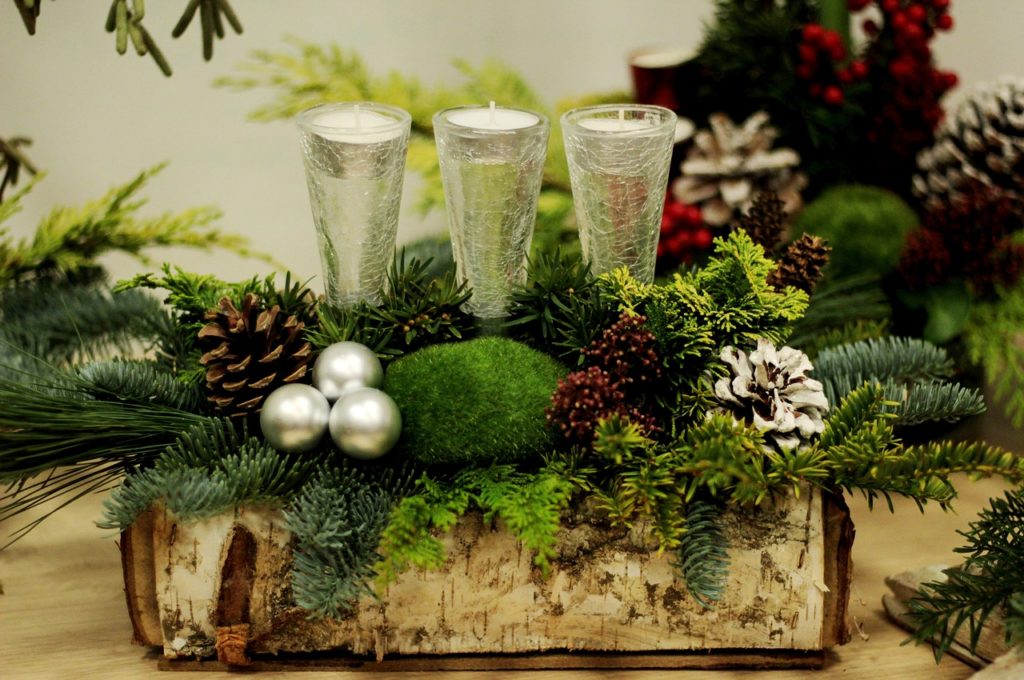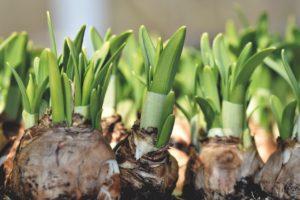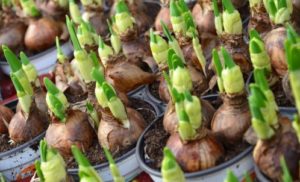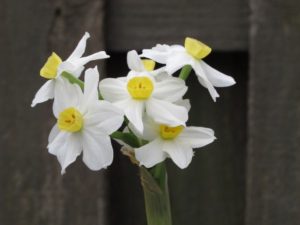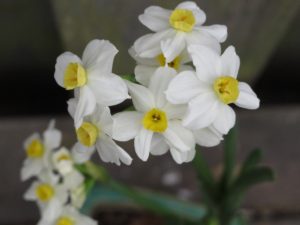
‘Winter Sun’ paperwhite daffodil.
The Paperwhite Narcissus
Among the easiest plants to grow for fragrant blooms in winter is the paperwhite narcissus, Narcissus papyraceus. Success is practically guaranteed, since the flowers are already inside the bulbs when you buy them. All they need to sprout is light and moisture. Yes—it’s that easy!
Bulbs are available in autumn, alongside their hardier daffodil cousins, and sometimes into winter. Narcissus papyraceus is the name used by the Royal Horticultural Society. It lists Narcissus papyraceus subsp. tazetta as a synonym.
Purchase the bulbs by the end of November if you want blooms for Christmas. But, if time is running short, garden centers and florists will have potted paperwhite narcissus already sprouting or in flower right up to Christmas and often into the New Year.
Look for large, healthy bulbs that feel solid when you lightly squeeze them. Bulbs generally will bloom 3 to 4 weeks after planting them; some require a week or two more. Keep them cool—in the 50’s F—until they’re planted.
How To Plant Paperwhite Narcissus Indoors
With Roots In Water
Many gardeners prefer the traditional method of growing bulbs on a bed of decorative gravel or pebbles. Simply place a layer of pebbles in a shallow non-draining ceramic bowl or a glass container. Maintain the water level just below the bottom of the bulbs, which will sense the humidity and begin to grow roots. It won’t be long before growth emerges.
If you don’t see roots within a few days, add water until it touches the bottom of the bulbs. Once roots are visible, maintain the water level right below the bulbs. When the bulbs begin absorbing water, remember to refill the container to keep the roots wet. Avoid submerging bulbs in the water, which can cause rot.
Another method of forcing paperwhite narcissus is to rest a bulb in the top of a “bulb-forcing vase”, keeping water just under the bottom of the bulb. These vases come in a few sizes, so look for the small one made for daffodils. Amaryllis bulbs are sometimes grown this way in a larger vase.
With Roots In Soil
I prefer forcing bulbs in potting soil. Place paperwhite narcissus bulbs for forcing close together, unlike bulbs planted in the garden. Several bulbs will fit in a 6″ or 7″ pot.
Put some potting soil in the bottom third of the pot and nestle in the bulbs. Then, add some soil between the bulbs, and see if you can layer in a few more. It’s okay if the bulbs’ noses protrude above the soil. Other gardeners might place the bulbs fully exposed on top of the soil. Now water the pot.
The root systems of paperwhite narcissus bulbs grow very vigorously. In fact, strong young roots often push the bulbs higher in the medium. Gently push them back down; eventually the roots will more securely grab the soil.
One or two bulbs in a small decorative pot also makes a lovely presentation. When selling plants at the Christmas shows, I offered sprouted single paperwhites in 3″ aged clay pots. The bulb was planted high with a collar of fluffy green sheet moss tucked in the soil around the inside rim of the pot. I added a twig and holiday ribbon or a few pieces of raffia around the leaves. Add a clay saucer…very cute. Perfect for a windowsill that’s too cold for other houseplants.
I also planted paperwhites in ceramic bowls, 6″ and 7″ pots, and in squares of burlap, with moss and a bow, surrounding the pots and saucers. Customers enjoyed choosing among the different presentations to fit their needs.
Larger Bulbs
When I sold potted paperwhites in the fall and early winter, I purchased the largest bulbs available from suppliers. This ensured the greatest number of flowers, 2 or 3 multi-flowering stems per bulb. They were worth the additional cost.
Will Paperwhite Narcissus Come Back Next Year?
Forced bulbs have been weakened by the process and require an extra year or two in the garden, gathering strength before they’ll bloom again. Paperwhite narcissus bulbs for forcing are planted close together, but space them about 6″ apart in the garden.
In colder climates throughout the U.S., most varieties are not winter hardy. Gardeners in Zones 8-11, however, can plant them outdoors, where they usually return every spring. At the end of this article, I include a list of varieties and their USDA hardiness zones.
If you plan to set them into the garden after enjoying the forced blooms, keep the plants moist, give them direct sunlight, and do not cut off the foliage. It’s the same for paperwhites as it is for spring-flowering bulbs: leaves photosynthesize, storing nourishment in the bulbs. The more carbohydrates produced, the more flowers you’ll see in the future. For all bulbs, therefore, wait until the foliage has yellowed before removing it.
If your plans include saving the bulbs for the garden, force your paperwhites in potting soil. But don’t expect much of a floral show in the next flowering cycle. Bulbs growing in pots have depleted all the stored energy and require sunshine, moisture, nutrients, and time to gather enough strength to flower again.
As you can see from the list of varieties, several are hardy in colder climates. Left in the garden, they will bloom according to seasonal cues. Like other daffodils, roots grow in autumn, followed by the blooms in late winter to spring.
Temperature
Average indoor temperatures encourage rapid sprouting. Bright green leaves emerge before the tightly budded flowers. Temperature is one factor that determines how quickly the plants grow. Bulbs planted in late November to early December will probably flower for Christmas if they’re given temperatures in the high 60’s to 70°F. Rates of growth can vary, though, depending on the cultivar.
Let’s say you planted your bulbs on Thanksgiving Day, but now prefer to delay the bloom as long as possible. This is where lowering the temperature can help. Plants in full bloom or showing flower buds will slow down their development if they are kept very cool. And I mean “back porch” cool!

Don’t let them freeze. Expose plants to temperatures in the 40’s to just about stop them in their tracks. They probably would survive close to freezing temperatures, but the leaves might flop over. Cool temperatures keep the plants shorter overall. If the leaves are falling over, gather them together and secure with ribbon or raffia to a stake.
Watch the weather forecast to see if the plants can be kept outdoors overnight. But don’t forget to water them. Incidentally, deer and rodents won’t eat your paperwhite narcissus.
Chill!
When you bring the plants in for the night, put them in a very cool location. On the floor near a chilly patio door or in a cold window should suffice. Or in the garage if it’s cool but not freezing. Avoid placing them where they’ll feel the warm dry air from the heater. Kept very cool, the flowers last longer and growth will slow down.
Sure, bring them in for a few hours while your friends are over. (Not everyone likes the fragrance, though, so you might ask your guests.) Some varieties are less fragrant and are noted as such in the list of varieties, below.
Of course, there is the option of just letting them grow without fussing over them. If plants are available at the garden center, simply replace the old with the new. But if you prefer to grow them yourself, potting up a few bulbs every 7 to 10 days will give you a succession of blooms.
Planters Outdoors
If the weather remains chilly but not freezing, you can incorporate pre-started pots of paperwhites into patio planter combinations. Add evergreens, berried boughs, pansies or violas, and seasonal embellishments. I did this a few times, and, given favorable weather conditions, the flowers lasted for weeks.
Light and Water for Paperwhite Narcissus
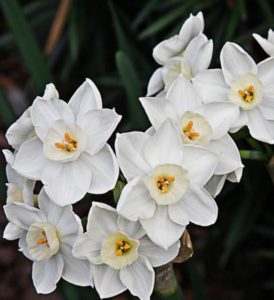
Another factor that determines how well the plants grow is light. Direct sunlight will keep them shorter, but along with that come higher temperatures. So, try to find a spot that’s cool and sunny, like a chilly window.
Plants grow weaker in low light levels, and flowers—if they open—will be of lower quality.
Keep the plants moist at all times, using cool tap water. A vigorous root system dries the pot quickly, so check the plants every day. Dry soil will damage the flower buds.
Please Pass the Vodka
 No, not for me. It’s for the paperwhites! In 2005, Dr. William Miller and student Erin Finan at the Cornell University Department of Horticulture studied the effects of alcohol on paperwhite narcissus.
No, not for me. It’s for the paperwhites! In 2005, Dr. William Miller and student Erin Finan at the Cornell University Department of Horticulture studied the effects of alcohol on paperwhite narcissus.
First, they gave clear water to the bulbs until they began rooting out. After that, they found that plants were about one-third shorter when bulbs received a 4-6% solution of alcohol. So, a 1:7 to 1:9 solution (alcohol:water) will keep the plants shorter. (Divide “proof” by 2 to get alcohol content. For example, 80 proof is 40% alcohol. 40 ÷ 5% target = 8. Subtract 1. This results in a ratio of 1:7.)
Some online sources recommend a more concentrated alcohol content (1:5), but I wonder if that would interfere with water uptake.
This works on paperwhites grown in water or in soil.
Fact of Life: Floppy Paperwhite Narcissus
Even with good growing conditions, the leaves of paperwhites grow tall and eventually fall over. Prepare for this ahead of time, and have some bamboo stakes, twigs from the garden, or a short decorative trellis and some twine, raffia, or ribbon to secure the stems. And maybe a little gin…for the bulbs.
Paperwhites offer a powerful fragrance. Maybe there are better places to display them instead of next to the Christmas turkey. For the same reason most cooks prefer unscented candles on the dinner table, paperwhites can find some other place for the occasion. Perhaps they can keep company with the cyclamen in the chilly foyer.
Cut Flowers
Many paperwhite cultivars are suitable as cut flowers. But water uptake in other types of flowers can be hindered by compounds in the daffodils’ sap.
This also applies to hardy springtime daffodils that emerge in the garden, so keep cut daffodils by themselves for longer-lasting tulips, hyacinths, and others.
Off With the Old
When the scent loses its appeal, trim off the entire flower stem. Don’t discard the plant; there might be another flower stem that will emerge, even if the bud is not immediately visible. Remember to keep the soil moist.
Place finished pots in the garage or a chilly basement, in the sun, and continue to water. Keep them growing if they’re hardy where you live. Gardeners can plant their bloomed-out paperwhites outdoors after the harsh months of winter have passed.
Even though the varieties I grew were not hardy in Maryland, where I used to live, the plants and their soil were discarded under the shrubs or in the borders instead of at the landfill. The organic matter still had value in the garden.
Varieties of Paperwhite Narcissus
Subspecies of N. papyraceus have broad distribution around the world. They’re native to or have naturalized in southeast France, northwest Italy, Sardinia, the Canary Islands, Turkey, Greece, Israel, southeast China, South Korea, Japan, India, and Nepal. They also are found in Australia, New Zealand, Algeria, Morocco, Bermuda, Mexico, South America, and in United States along the south and west coasts.
The term tazetta derives from the Italian word “tazza”, which is a shallow wine cup. These plants used to be called Narcissus tazetta, but recent nomenclature classifies them as Narcissus papyraceus subspecies tazetta. All paperwhites are in the Amaryllidaceae family.
Alphabetically, and all are fragrant:
- ‘Ariel’: large pure white flowers that face down slightly. Good for forcing, one source says grow only in soil. Zones 8-11.
- ‘Avalanche’: white with greenish-yellow cup, strong fragrance. Called ‘Seventeen Sisters’ in the 1700’s for its profuse blooms. Heirloom; award winner. Mid-spring, zones 6-9.
- ‘Canaliculatus’: white with yellow cup, sweetly fragrant, 4 to 7 flowers per stem. Short, to 6″ tall. Heirloom. Mid-spring, zones 6-10.
- ‘Chinese Sacred Lily’ (N. tazetta chinensis or orientalis): white with golden yellow cup, wonderful fragrance, 5 to 10 small flowers per stem, might be not as free-flowering as others. One source said to give it a little bottom heat (about 70°F) to coax the flowers. Three to five weeks to bloom. To 16″ tall. Brought from China in the 1800’s and used to celebrate Chinese New Year. Zones 8-11.
- ‘Cragford’: white with vivid orange cup, 4 to 6 flowers per stem. Excellent cut flower (strong stem). Good forcer, 1′ to 2′ tall. Heirloom, award winner. Zones 5-9.
- ‘Erlicheer’: double white with yellow mixed in, to 16″ tall. Award winner. Zones 6-9.
- ‘Falconet’: deep yellow with orange-red cup, 3 to 8 flowers per stem, strong fragrance. Excellent cut flower, 1′ to 2′ tall. Award winner. Mid-spring, zones 5-9.
- ‘Galilee’: all white, 10 to 15 flowers per stem, musky scent. Good for forcing. Zones 8-11.
- ‘Geranium’: white with yellow-orange cup, very fragrant. Several stems, each with 3 to 6 flowers. Well-drained soil, good in the South. Up to 15″ tall. Award winner. Zones 4-9.
- ‘Grand Soleil d’Or’: bright yellow with orange cup, 10 to 20 flowers per stem. Delicate fruity fragrance. Good forcer but takes longer to grow. To 18″ tall. Very early spring, zones 8-11.
- ‘Inbal’: large clusters of white flowers, flat cup. Good for forcing, milder fragrance. Zones 8-11.
- ‘Jerusalem’: large white flowers, mild sweet fragrance. To 20″ tall. Zones 8-11.
- ‘Minnow’: pale yellow with yellow cup, fading with age, 2 to 5 flowers per stem. 8″ to 10″ tall, nice in rock gardens. Award winner. Zones 5-9.
- ‘Nazareth’ (‘Yael’): creamy white, mildly sweet fragrance. To 14″ tall. Zones 8-11.
- ‘Scilly White’: white with short pale yellow cup, 3 to 20 flowers per stem. Sweet scent, but not as strong as others. To 20″ tall. Late winter/early spring flowers. Zones 8-11.
- ‘Winter Sun’ (‘Wintersun’): white with buttery-yellow to clear yellow cup. 4 to 5 weeks to bloom, milder fragrance. Zones 8-10, one source said Zones 9-11. (Photo, below).
- ‘Ziva’: pure white, large cluster. 3 to 4 stems per bulb. Sweet, spicy scent. Zones 8-11. Also, the favorite for forcing.
If you prefer a milder fragrance, start with those indicated as such in the list above. Photographs of several cultivars can be found online.
In the meantime, I hope you’ll enjoy potting up a few of these paperwhite narcissus bulbs. Tuck a pot into a large basket with other winter flowers (Amaryllis, Poinsettia), some English ivy, and ‘Frosty’ fern for a festive arrangement.
Merry Christmas and Happy Holiday Season to all!
